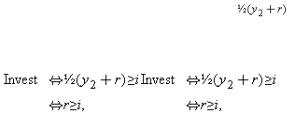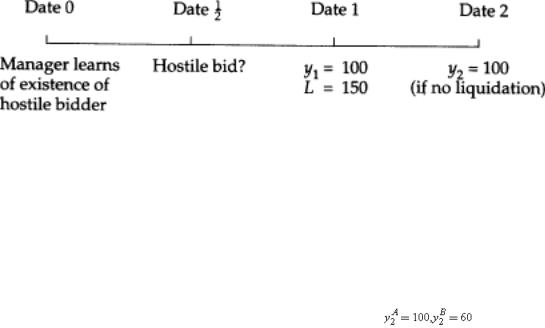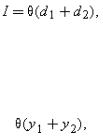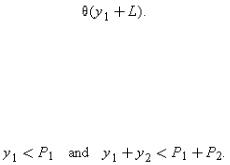
Учебный год 22-23 / Firms, Contracts, and Financial Structure
.pdf
140 |
II. UNDERSTANDING FINANCIAL STRUCTURE |
attached saying that the firm can issue new debt of the same seniority up to a further amount K (so that the total debt outstanding becomes 2K). Any debt beyond this is junior to this class of senior debt.
Given such a capital structure, the most that the firm can rise at date 1 is . The firm does this by issuing the full amount K of new debt and dividing total date 2 income (y2+r) between the old and new creditors. (Recall that K is very large, so that the firm is bankrupt at date 2.) Thus, the condition for the firm to invest is now
since y2=r. But this yields precisely the first-best outcome. Moreover, it is easy to check that the first-best cannot be achieved with a simple capital structure consisting solely of (a fixed amount of) senior debt.
Not only are more sophisticated securities of theoretical interest, but also they are observed in practice (see Ragulin 1994). Unfortunately, a general analysis of sophisticated securities is beyond the scope of this book; for some progress in this direction, readers are referred to Hart and Moore (1995). Note also that the existence of sophisticated securities does not detract from the main theme of this chapter: that debt has an important role in constraining the behaviour of self-interested management.
4.Model 3
Assumption 1 was useful in simplifying model 2, but it ruled out an interesting economic case, stressed particularly by Jensen (1986). If y1>i, the firm has free cash flow and it may use this to make unprofitable investments (i.e. it may invest when r<i). Short-term debt then has a role in forcing the manager to pay out this free cash flow.
Note that this role of short-term debt differs from that in model 1, where short-term debt was used to trigger liquidation, rather than to prevent expansion.
6. CAPITAL STRUCTURE OF A PUBLIC COMPANY |
141 |
I analyse this new role of short-term debt in the Appendix. To do so I combine models 1 and 2. However, merging the models in general is difficult and so two simplifying assumptions are made. First, it is supposed that the manager has an unlimited number of new investment projects (rather than just one) and that they are unprofitable; i.e., r<i for each of them. (In fact, for simplicity, r is taken to be zero.) Second, it is supposed that y2>L; i.e. liquidation is always inefficient (as in Assumption 1). The choice of debt is then determined by the following considerations. To minimize the resources the manager has for unprofitable reinvestment, P1 and P2 should be set high: as close to y1 and y2 as possible. However, to minimize the chances that inefficient liquidation is triggered because of an adverse y1 or y2 shock, P1 and P2 should be set low. The solution to this trade-off is derived in the Appendix.
One point that is worth noting for future reference is that, if y1 and y2 are certain, then the first-best can be achieved in model 3 by setting P1=y1 and P2=y2.
5.Observed Patterns of Capital Structure
Having developed some simple models of debt—equity choice, I consider next what light these models can throw on actual capital structure choices. A great deal of empirical work has been done on capital structure. Although not all the findings agree, some stylized facts have emerged. I shall take these facts as given in what follows.
The stylized facts are that profitable firms have low debt; that firms with a large proportion of tangible assets have high debt; that firms with stable cash flows have high debt; that debt-for-equity swaps raise share prices; that equity-for- debt swaps lower share prices; and that pure equity issues lower share prices.157
I shall argue that all of these facts can be explained by the models described above. However, not all are inevitable consequences of these models. In some cases the models predict that reversals
157 For discussions of these, see Harris and Raviv (1991), Masulis (1988), Myers (1990), Asquith and Mullins (1986), Kester (1986), Long and Malitz (1985) Masulis (1980), and Titman and Wessels (1988).

142 |
II. UNDERSTANDING FINANCIAL STRUCTURE |
could also be observed. Some may regard this ambiguity as a weakness of the agency approach to debt. I suspect, however, that this feature is shared by other theories of capital structure. That is, if ‘suitable’ assumptions are made about parameter values and the structure of information, other theories can also predict reversals. I shall argue below that one advantage of the agency approach over other theories is that the agency approach can explain something that other theories cannot explain: why firms issue ‘hard’ debt, i.e. debt that is senior and that triggers bankruptcy in the event of default.
Consider the relationship between profitability and debt. Model 1 can explain why profitable firms (in particular, those with high y2) have low debt. Suppose there are two categories of firms, category 1 firms with y2>L and category 2 firms with y2<L, and it is known which category any firm is in. Suppose also that category 1 firms are more profitable than category 2 firms, say, because L doesn't vary very much across the categories while y2 does. Then for profitable category 1 firms it is optimal to set P1=P2=0 since liquidation is inefficient. On the other hand, for unprofitable category 2 firms it is optimal to set P1 large since liquidation is efficient. Thus, there is a negative relationship between profitability and the debt level.
However, a small change in the assumptions could generate a positive relationship between profitability and the debt level. Suppose that category 1 firms are less profitable than category 2 firms because L varies a lot across the categories while y2 does not. In other words, suppose profitable firms are profitable because they have high liquidation values, rather than because they have high going concern values. In such cases, high debt levels will be required to force managers of profitable firms to relinquish control by liquidating them (more generally, by selling off assets).
Model 2 does not predict a clear relationship between profitability and debt either. If a firm's profitability refers to the value of new investment, it is optimal for profitable firms to have low debt. (If r>i with certainty, the optimal P1=P2=0.) However, if profitability refers to the value of old investments, then it is optimal for profitable firms to have high debt. In subcase 1 of the two-state case, i.e. when , the optimal P2 lies between  and
and  ,
,
6. CAPITAL STRUCTURE OF A PUBLIC COMPANY |
143 |
and is thus increasing in  . (For more on this, see Hart and Moore (1995).)
. (For more on this, see Hart and Moore (1995).)
Model 3 gives a fairly clear prediction that profitability and debt should be negatively related (where debt is measured by the debt–equity ratio). Suppose y1, y2 double. If L doubles as well, then the optimal amount of debt doubles by homogeneity (see the Appendix for details). However, if L less than doubles, then, since the cost of inefficient liquidation has effectively risen, the optimal level of debt less than doubles. Thus, the debt–equity ratio falls as going concern value rises relative to liquidation value.
Consider next the fact that firms with a large fraction of assets that are tangible have high debt. If tangibility is associated with high liquidation value, then model 1 explains this fact rather clearly. Other things equal, a high L makes liquidation more attractive and so raises the optimal P1, P2. (It is more likely that y2<L or that (6.3) will be satisfied.)
Model 2 seems to have little to say about the relationship between debt and asset tangibility because there is no obvious proxy for asset tangibility in this model.
Model 3, like model 1, supports the existence of a positive relationship between debt and asset tangibility. If the liquidation value of the assets goes up, then the cost of high debt—that inefficient liquidation sometimes occurs—falls. However, the benefit of high debt—that unprofitable reinvestment is prevented—stays the same. Thus, the optimal debt level rises. See the Appendix for details.
Consider next the relationship between debt and the stability of cash flows. The best way to understand this is to consider model 3. Start off with the case where y1 and y2 are certain. It is then optimal to set P1=y1, P2=y2. Now introduce uncertainty in date 1 cash flows. There are two effects. On the one hand, in order to reduce the manager's ability to make wasteful investments when y1 is high, debt must rise. On the other hand, in order to reduce the likelihood that inefficient liquidation occurs when y1 is low, debt must fall. It is shown in the Appendix that, depending on the parameters, either effect may dominate, and so the optimal level of debt may rise or fall.
So the theory can explain why firms with stable cash flows have more debt, but it can also explain the opposite. Turn next to the event studies. I will focus on the first of these—that
144 |
II. UNDERSTANDING FINANCIAL STRUCTURE |
debt-for-equity swaps typically raise share prices. (A very similar analysis can be applied to the other event studies.) I will also base the discussion on model 1, although similar results could be obtained for the other models. In much of what follows, the driving force behind a recapitalization or swap is the threat of a hostile take-over.
Debt-For-Equity Swaps Typically Raise Share Prices
To see that model 1 can explain this, suppose that management obtains private information just after date 0 that a hostile take-over is imminent. (It will occur at date ½, say.) Assume for simplicity that as far as the market is concerned this is a very unlikely event. However, if management signals the event through a recapitalization, then the market of course reacts.
Assume also that for unspecified (e.g. historical) reasons the firm initially consists of 100 per cent equity, and that the hostile bid will succeed unless management can convince the market that it will run the firm approximately efficiently. (The idea is that management is safe if it is close to efficient, because there are some costs in making a bid.)
Suppose it is known that for this firm y1=y2=100 and L=150, as in Figure 6.3. In the absence of any action by management before a bid is made at date ½, market participants will reason that, if the bid fails, management will not liquidate at date 1 because, given that the firm has no outstanding debt, it will be under no pressure to do so.158 Anticipating this, shareholders tender to the bidder and the bid succeeds.
To prevent this outcome, management must bond itself just after date 0 to take an efficient action at date 1. An obvious way to do this is to make a debt-for-equity swap.159 For example, suppose management issues new short-term debt promising 250 (that is, it sets P1=250 and P2=0) and uses the proceeds to buy back equity. Because y1<P1 and y1+y2<P1+P2, the new debt guarantees that the firm will default at date 1 and be liquidated then, which is the efficient outcome. Thus, the hostile take-over is thwarted, and management retains control, if only until date 1.
158Assume that the chances of another bidder appearing later are negligible.
159I assume that it is too late to make such a swap after the take-over bid is announced.

6. CAPITAL STRUCTURE OF A PUBLIC COMPANY |
145 |
Fig. 6.3
What is the effect of the recapitalization on the value of equity? Before the recapitalization the equity was worth (approximately) y1+y2=200 (given that the take-over was regarded as a very unlikely event). Afterward the total value of the firm is y1+L=250. Given that all the capital raised by the new debt is used to buy back shares, all of this 250 accrues to initial shareholders. Thus, the effect of the recapitalization is to raise the value of equity by 50.160
Model 1 is thus consistent with the apparent fact that debt-for-equity swaps raise the value of equity. However, I now show that, under a different information structure, model 1 predicts that such swaps can reduce the value of equity.
Debt-For-Equity Swaps Can Lower Share Prices
Suppose that y1=100, L=80, and y2 is known to take on two possible values, , with probabilities πA and πB=1−πA, respectively. Assume that, ex ante, πA is very close to 1 and πB is very close to zero. However, imagine that management receives private information just after date 0 that in fact state B is sure to occur. (The receipt of this information is very unlikely ex ante.) This information will very shortly become available to the market—at date ¼ say. In addition, in contrast to the previous example, everyone already knows that a hostile bidder is ready to make a bid at date ½. Again, assume that the firm is initially all equity. The information structure is shown in Figure 6.4.
160In the above example, the firm was all equity before the debt–equity swap. It is easy to show that the main ideas generalize to the case where the firm has some riskless debt initially outstanding; in this case the threat of a hostile take-over leads the firm to take on more debt. However, matters become more complicated if there is uncertainty and the firm has risky debt. The reason is that the take-over bidder may be deterred from making a bid because he must share some of the gains with creditors. On this, see Israel (1991) and Novaes and Zingales (1994).

146 |
II. UNDERSTANDING FINANCIAL STRUCTURE |
Fig. 6.4
Given that, in ex ante terms, state A is very likely, management would have no incentive to deviate from the all-equity structure in the absence of the information that state B is going to occur. (In that case it would adjust its estimate of πA even closer to 1.) The point is that an all-equity firm is under no pressure to liquidate at date 1. But, since πA is close to 1, this outcome is approximately efficient, so management is safe from a take-over at date ½. The market's ex ante valuation of the initial equity is therefore approximately  .
.
Management, however, knows that the market will soon learn to its surprise that the bad state B is the true state. Given this, management's job will be in jeopardy unless it can bond itself to liquidate at date 1, since in state B liquidation is efficient.161 One thing management can do is to make a debt-for-equity swap. For example, it might set P1=180. This commits it to liquidation at date 1 in state B and thus thwarts the hostile take-over at date ½.
Of course, given this information structure, management's recapitalization signals that it has learned unfavourable information about the state, in particular that state B will occur. The new debt, however, is riskless (because ) and so sells for 180. Since all of this accrues to initial shareholders, the value of equity when the recapitalization is announced is also 180. This represents a drop in equity value from 200 even though the recapitalization is in the interest of investors. The point is that the bad news about the state signalled by the
recapitalization offsets the increased bonding.162
161 I assume that bonding must occur before the market learns the true state at date ¼ and a fortiori before a bid occurs at date ½. (Dates ¼ and ½ might be very close together.)
162The idea that a managerial action that serves shareholders can cause a decline in share price because the action reveals bad news about the company is far from new; see e.g. Shleifer and Vishny (1986b).

6. CAPITAL STRUCTURE OF A PUBLIC COMPANY |
147 |
Thus, model 1 can explain not only the apparent fact that debt-for-equity swaps raise the price of equity but also the reverse.
6.Other Theories of Capital Structure
As I have noted previously, much of the literature on capital structure does not take an agency perspective. In fact, since Modigliani and Miller's famous irrelevance theorem (Modigliani and Miller 1958), the literature has tended to focus on the role of taxes, asymmetric information, or incomplete markets as explanations of capital structure decisions, rather than on agency problems. In the last part of this chapter, I want to discuss briefly why I think an agency perspective is important, and in particular why the conflict of interest between a company's managers and its investors is crucial for an understanding of capital structure. I shall argue that a great advantage of the agency approach over other theories in the literature is that the agency approach can explain why firms issue senior debt and why a failure to make debt payments leads to a penalty in the form of bankruptcy. A considerably more detailed account of the ideas presented here can be found in Hart (1993).
It is helpful to use model 1 as a vehicle for this discussion. Maintain all the assumptions of model 1, except the assumption that the manager is self-interested. In other words, suppose now that the manager obtains no control benefits and therefore is completely indifferent about whether the firm is liquidated at date 1. (It is supposed that the manager is reliable and honest, but has a ‘normal’ interest in money.) It is then a simple matter to achieve the first-best with an all-equity capital structure, by putting the manager on the following incentive scheme:(6.7)
where d1, d2 are dividend payments made to shareholders at dates 1 and 2, respectively, and θ is a small positive number. The point is that this motivates the manager to maximize the firm's value (and, since θ is small, is almost costless for the shareholders). If the manager keeps the firm going at date 1, he receives(6.8)

148 |
II. UNDERSTANDING FINANCIAL STRUCTURE |
while if he liquidates it he receives(6.9)
Obviously, the manager will liquidate if and only if y2<L, which is the first-best outcome.
Not only can the efficient outcome be achieved through an all-equity capital structure with a suitable compensation package for management, but any other capital structure will typically lead to inefficiency. This is clear from the earlier discussion of model 1. It was observed there that the manager cannot avoid liquidation if(6.10)
However, if P1, P2>0, (6.10) may be satisfied when y2>L, i.e., under weak assumptions, there will be some states where liquidation will occur even when it is inefficient.
A similar argument applied to model 2 shows that debt is also costly because it prevents the (selfless) manager from carrying out some profitable investment projects (the ‘debt-overhang problem’).
The conclusion so far is that, if managers are not self-interested, firms should not issue debt at all. However, up to now I have ignored taxes. In most advanced capitalist economies, interest income on debt is tax-advantaged relative to dividend income. It is often argued that this explains why firms issue debt. In fact, many papers in the literature develop a theory of optimal capital structure based on this idea: debt is good because it reduces corporate taxes, but bad because it may cause inefficient liquidation (when (6.10) is satisfied).
However, taxes by themselves cannot explain why firms issue debt claims of the type analysed in this chapter.163 If managers are not self-interested, the first-best can be achieved if the firm issues only postponable debt in the form of payment-in-kind (PIK) bonds.164 In other words, the firm would owe a large amount of money P1 at date 1 and a large amount of money P2 at date 2, but the manager would be given the discretion to postpone part of P1 (in the event that y1<P1). The advantage of such an arrangement is that, if P1 is chosen to be high, the firm can get all the tax advantages
163 In the following discussion I ignore personal taxes. This means that the issues raised in Miller (1977) do not arise.
164PIK bonds give management the option of paying interest in cash or in additional securities. They were used extensively in LBOs in the USA during the 1980s. See Tufano (1993) and Bulow et al. (1990).
6. CAPITAL STRUCTURE OF A PUBLIC COMPANY |
149 |
of paying income out as interest rather than dividends; but at the same time the manager can avoid inefficient liquidation by postponing (P1−y1) of the current debt owed when P1>y1. Moreover, the selfless manager will never postpone if liquidation really is efficient, given that he is on the incentive scheme (6.7). (d1, d2 should now be interpreted as combined payments to creditors and shareholders.)165
A similar argument applied to model 2 shows that tax considerations cannot explain why firms issue senior (long-term) debt. In particular, if managers initially issue only junior debt (that is, debt with a covenant allowing the firm to issue debt senior to it in the future), then the firm can get all the tax advantages of debt, but at the same time always be able to finance good investment projects later by issuing new, senior debt (i.e. the firm avoids the debt-overhang problem).
In reality, firms issue significant amounts of senior, non-postponable, debt.166 It may be concluded that other forces than simply taxes are at work.
Next, consider the role of asymmetric information in explaining debt. Myers and Majluf (1984) have argued that a manager who has private information about a firm's profitability may prefer to issue debt rather than equity. To understand their argument in the context of model 1, suppose that the manager learns y2 at date 1, whereas the market learns this only at date 2. Suppose also that for some (unexplained) historical reason the firm has short-term debt P1>y1. Under these conditions, a manager who is a significant shareholder, or who acts on behalf of initial shareholders, will issue debt rather than equity to repay P1 if he learns that y2 is high. The reason is that, given that the market undervalues the firm's going concern value, the manager would prefer to raise capital by borrowing than by issuing equity since in the latter case initial shareholders' equity (including his own) is diluted.
165 Before 1989 US corporations apparently faced few restrictions on their ability to use PIK bonds to wipe out taxable income. Since 1989 the Revenue Reconciliation Act has constrained them. See Bulow et al., (1990).
166Smith and Warner (1979) found that, in a random sample of 87 public issues of debt registered with the Securities and Exchange Commission between January 1974 and December 1975, more than 90% of the bonds contained restrictions on the issuing of additional debt. Although the strength of such debt covenants declined during the 1980s, it is still very common for new public debt issues to contain some restrictions on new debt. See Lehn and Poulsen (1992).
